- Home
- Richard Dawkins
Outgrowing God Page 3
Outgrowing God Read online
Page 3
The long gap between Jesus’s death and the gospels being written gives us one reason to doubt that they are a reliable guide to history. Another is that they contradict each other. Although all the gospels agree that Jesus was accompanied by twelve close disciples, they don’t agree on who they all were. Matthew and Luke trace the descent of Mary’s husband Joseph from King David via two completely different sets of ancestors, 25 of them in the case of Matthew, 41 in Luke. To make matters worse, Jesus was supposed to be born of a virgin mother, so Christians can’t use Joseph’s descent from David to establish that Jesus was descended from David. There are also discrepancies between the gospels and known historical facts, for example the facts of Roman rulers and their doings.
Yet another problem with taking the gospels as historical truth is their obsession with fulfilling Old Testament prophecies. Especially Matthew. You get the feeling Matthew was quite capable of inventing an incident and writing it into his gospel, simply in order to make a prophecy come true. The most glaring example is his invention of the legend that Mary was a virgin when she gave birth to Jesus. And that’s a legend that’s really taken on a life of its own. Matthew tells how an angel appeared to Joseph in a dream, reassuring him that his intended wife Mary was pregnant not by another man but by God. (That, by the way, differs from Luke’s account, where the angel appears to Mary herself.) Anyway, Matthew goes on, without a hint of shame, to admit to his readers:
All this took place to fulfil what the Lord had said through the prophet: ‘The virgin will be with child and will give birth to a son, and they will call him Immanuel’ – which means, ‘God with us.’
Perhaps ‘shame’ was the wrong word for me to use. Matthew, whoever he was, had a different idea of historical truth from ours. For him, fulfilling a prophecy was more important than what actually happened. He wouldn’t have understood why I said ‘without a hint of shame’.
On the other hand, Matthew totally misunderstood the prophecy. It’s in Isaiah, chapter 7. And it’s clear from the Book of Isaiah itself – though apparently not to Matthew – that Isaiah was talking not about the distant future, but about the immediate future in his own time. He was talking to the king, Ahaz, about a particular young woman in their presence, who was pregnant even as he spoke.
The word Matthew quoted as ‘virgin’ was almah in Isaiah’s Hebrew. Almah can mean virgin; but it can also mean ‘young woman’ – rather like the English word ‘maiden’, which has both meanings. When Isaiah’s Hebrew was translated into Greek in the version of the Old Testament called the Septuagint, which Matthew would have read, almah became parthenos – which really does mean ‘virgin’. A simple translation error spawned the entire worldwide myth of the Blessed Virgin Mary, and the Roman Catholic cult of Mary as a kind of goddess, the ‘Queen of Heaven’.
It was the same determination to fulfil prophecies that led both Matthew and Luke to have Jesus born in Bethlehem. Another one of the Old Testament prophets, Micah, had foretold that the Jewish Messiah would be born in Bethlehem, the ‘City of David’. John’s gospel, reasonably enough, assumes that Jesus was born in Nazareth, which is where his parents lived. John tells of people being surprised that Jesus, if he really was the Messiah, was born in Nazareth. Mark doesn’t mention his birth at all. But both Matthew and Luke wanted to fulfil the prophecy of Micah, and both scrambled to find a way to shift Jesus’s birthplace from Nazareth to Bethlehem. Unfortunately they did it in two different, contradictory, ways.
Luke’s solution to the problem was a tax decreed by the Roman Emperor Augustus. This tax, according to Luke, was accompanied by a census. Luke messed up his dates here, because modern historians know there was no Roman census at the right time to fit the story. But let that pass. In order to be properly counted in the census, everybody had to go to ‘his own city’. Although Joseph actually lived in Nazareth, his ‘own city’, according to Luke, was Bethlehem. Why? Because he was descended in the male line from King David, and David came from Bethlehem. That’s ridiculous in itself, by the way. By Luke’s own account, David was Joseph’s 41-greats-grandfather. How could any law define a man’s ‘own city’ as the city where his 41-greats-grandfather was born? Do you have the faintest idea who your 41-greats-grandfather in the male line was? I doubt that even Queen Elizabeth knows. Anyway, according to Luke, that was why Jesus was born in Bethlehem. His parents moved from Nazareth to be in the birthplace of Joseph’s 41-greats-grandfather, for the census.
Matthew’s way of fulfilling Micah’s prophecy was different. He apparently assumed that Bethlehem was Mary and Joseph’s home town, and that was why Jesus was born there. Matthew’s problem was how to move them to Nazareth later. So he had the wicked King Herod getting wind of Jesus’s birth in Bethlehem. Fearful of a prophesied new ‘King of the Jews’ who would topple him off his throne, Herod ordered all the boy babies in Bethlehem to be killed. God sent an angel to warn Joseph in a dream, telling him to flee with Mary and Jesus to Egypt. Perhaps you’ve sung the Christmas carol which goes:
Herod then with fear was filled:
A prince, he said, in Jewry!
All the little boys he killed
At Bethl’em in his fury.
Mary and Joseph heeded the warning, and didn’t return from Egypt until after Herod’s death. However, even then they avoided Bethlehem because God warned Joseph, in another dream, that they wouldn’t be safe there from Herod’s son Archelaus. So they went and lived, instead,
in a town called Nazareth, that it might be fulfilled which was spoken by the prophets, He shall be called a Nazarene.
Neat solution by Matthew. He got his Jesus character safely to Nazareth, and even managed to score another fulfilled prophecy in the process.
I said I’d return to those extra gospels, about fifty of them, any of which might have been included in the canon along with Matthew, Mark, Luke and John. They were mostly written down in the first couple of centuries AD but, as with the four official gospels, those final written versions were based on older word-of-mouth traditions (complete, presumably, with the usual ‘Chinese Whispers’ distortions). They include the gospel of Peter, the gospel of Philip, the gospel of Mary Magdalene, the Coptic gospel of Thomas, the infancy gospel of Thomas, the gospel according to the Egyptians and the gospel of Judas Iscariot.
In some cases it’s easy to see why they were left out of the canon. Take the gospel of Judas Iscariot, for example. Judas was the arch-villain of the whole Jesus story. He betrayed Jesus to the authorities who then arrested, tried and executed him. According to the gospel of Matthew, his motive was greed: the betrayal earned him 30 pieces of silver. The trouble with Matthew is that, as we’ve seen, he was obsessed with Old Testament prophecies. Matthew wanted everything that happened to Jesus to be the fulfilment of a prophecy. And we might wonder whether Judas, with his alleged greed motive, was a victim of Matthew’s prophet fixation. Here are some clues, which I learned from the biblical historian Bart Ehrman.
The prophet Zechariah (chapter 11, verse 12) was paid 30 pieces of silver. Not a very impressive coincidence. Until you see the next verse from Zechariah:
So they paid me thirty pieces of silver. And the Lord said to me, ‘Throw it to the potter’ – the handsome price at which they valued me! So I took the thirty pieces of silver and threw them into the house of the Lord to the potter.
Hold ‘potter’ and ‘threw’ in your head while we go back to Matthew, chapter 27. Full of remorse, Judas took his 30 pieces of silver to the chief priests and elders.
When Judas, who had betrayed him, saw that Jesus was condemned, he was seized with remorse and returned the thirty silver coins to the chief priests and the elders. ‘I have sinned,’ he said, ‘for I have betrayed innocent blood.’ ‘What is that to us?’ they replied. ‘That’s your responsibility.’ So Judas threw the money into the temple and left. Then he went away and hanged himself. The chief priests picked up the coins and said, ‘It i
s against the law to put this into the treasury, since it is blood money.’ So they decided to use the money to buy the potter’s field as a burial place for foreigners.
The chief priests didn’t want to accept blood money. So instead they used the 30 pieces of silver to buy a field called…the Potter’s Field. True to form, Matthew rounds off with yet another prophet, this time Jeremiah:
Then what was spoken by Jeremiah the prophet was fulfilled: ‘They took the thirty silver coins, the price set on him by the people of Israel, and they used them to buy the potter’s field, as the Lord commanded me.’
The rediscovery of the gospel of Judas was one of the most surprising document finds of the twentieth century. People knew that such a gospel had been written, because it was mentioned, and condemned, by early Church Fathers. But everybody thought it was lost, perhaps destroyed as heresy. And then, after 1,700 years, in the late 1970s, it was discovered in a tomb in Egypt. As is usually the case with such finds, it took a while for this priceless document to find its way into the hands of proper scholars capable of taking care of it, and it suffered some damage on the way. It has been carbon-dated to AD 280, plus or minus sixty years.*
The rediscovered document is written in Coptic, an old Egyptian language. But it is thought to be a translation from an earlier, and still lost, Greek text, which was probably nearly as old as the four canonical gospels. Like those four, it was written by somebody other than its named author: so probably not Judas himself. It’s mostly a set of conversations between Judas and Jesus. It tells the story of the betrayal, but from Judas’s point of view, and it removes much of the blame from him. It suggests that Judas was the only one of the twelve disciples who really understood Jesus’s mission. As we shall see in Chapter 4, Christians believe it was God’s plan that Jesus should be arrested and killed, so that God could forgive humanity’s sins. Judas’s ‘betrayal’ was really helping Jesus fulfil God’s plan. He was doing Jesus, and God, a favour. If that sounds strange (it does), it gets its strangeness straight from the central idea of Christianity: that Jesus’s death was a necessary sacrifice, planned by God. You can see why the Council of Nicaea might not want to include the gospel of Judas in the canon.
For different reasons, it’s no surprise that they didn’t want the infancy gospel of Thomas either. As usual, nobody knows who wrote it. Contrary to rumour, it wasn’t ‘Doubting Thomas’, the disciple who wanted proof before he believed in Jesus’s resurrection (perhaps he should be the patron saint of scientists). This gospel includes amazing stories about Jesus’s childhood, a period of his life that’s almost completely missing from the official canon. By its account Jesus was a mischievous child, who was not shy of showing off his magic powers. At the age of five, playing by a stream, he took mud from the stream and fashioned it into twelve live sparrows.
A sparrow is made of more than 100 billion cells. Nerve cells, muscle cells, liver cells, blood cells, bone cells and hundreds more different types of cell. Every one of those cells is a miniature machine of mind-blowing complexity. Every one of a sparrow’s two thousand feathers is a marvel of delicate architecture. Nobody knew those details in Jesus’s time. Even so, you’d think the grown-ups would have been pretty impressed. To make all that out of mud, at a stroke, would be an astounding feat of magic. But no: Joseph gave higher priority to scolding Jesus because he did it on the sabbath day, when Jewish law forbids you to do any work. Some modern Jews won’t even flick a light switch on the sabbath. They have a time-switch to do it for them. And there are apartment buildings where, on the sabbath, the lifts stop at every floor – so you don’t have to ‘work’ by pressing a button.
Jesus’s response to being scolded was to clap his hands and say: ‘Be gone.’ Obediently the sparrows flew off, chirping.
According to the infancy gospel, the young Jesus also used his magic powers in less appealing ways. On one occasion he was walking through the village and another child ran up and bumped into his shoulder. Jesus was cross and said to him, ‘You will go no further on your way.’ That very night the boy fell down dead. Understandably, the grieving parents complained to Joseph and asked him to control Jesus’s use of his magic powers. They should have known better: Jesus promptly struck them blind. On an earlier occasion Jesus was annoyed with a boy and cursed him so that his body completely withered up.
It wasn’t all bad. When one of his playmates fell off a roof and died, Jesus brought him back to life. He saved a number of people in the same kind of way, and once healed a man who accidentally chopped into his own foot with an axe. One day he was helping his carpenter father, and it turned out that a piece of wood was too short. Well, Jesus wasn’t going to let a little problem like that spoil a good piece of work! He simply lengthened the wood with one of his magic spells.
Nobody thinks the fantastic miracles in the infancy gospel of Thomas really happened. Jesus didn’t turn mud into sparrows, didn’t kill the boy who bumped into him or blind the boy’s parents, or lengthen the piece of wood in the carpenter’s shop. Why, then, do people believe the equally far-fetched miracles described in the official, canonical gospels: turning water into wine, walking on water, rising from the dead? Would they have believed the sparrow miracle, or the plank-lengthening miracle, if the infancy gospel had made it into the canon? If not, why not? What’s so special about the particular four gospels lucky enough to be chosen for the canon by a bunch of bishops and theologians in Nicaea in AD 325? Why the double standard?
Here’s another example of the double standard. Matthew tells us that, at the exact moment of Jesus’s death on the cross, the great curtain in the temple in Jerusalem was split down the middle, the earth shook, the tombs broke open and dead people walked the streets. According to the official gospel, then, Jesus wasn’t unusual in being resurrected. Only three days before Jesus did it, lots of other people burst out of their graves and walked the streets of Jerusalem. Do Christians really believe that? If not, why not? There’s as much reason (or, more to the point, as little reason) to believe it as there is to believe in Jesus’s own resurrection. How do believers decide which far-fetched tales to believe and which to ignore?
As I said, most, though not all, historians think Jesus existed. But that isn’t saying much. ‘Jesus’ is the Roman form of the Hebrew name Joshua or Yeshua. It was a common name and wandering preachers were common. So it’s not unlikely there was a preacher called Yeshua. There could have been many. What is not believable is that any of them turned water into wine (or mud into sparrows), walked on water (or lengthened a piece of wood), was born to a virgin or rose from the dead. If you want to believe such things, you’d do well to look for much better evidence than is at present available. As the astronomer Carl Sagan said, ‘extraordinary claims require extraordinary evidence’. He may have been inspired by Laplace, the renowned French mathematician, who said: ‘The weight of evidence for an extraordinary claim must be proportioned to its strangeness.’
The claim that a wandering preacher called Jesus existed is not an extraordinary claim. And the evidence, though slight, is ‘proportioned’: small evidence for a small claim. Yeshua probably existed. But the claims that his mother was a virgin, and that he rose from the grave, are very extraordinary indeed. So the evidence had better be good. And it isn’t.
The great eighteenth-century Scottish philosopher David Hume had something to say about miracles, and I’d like to talk about it because it’s important. I’ll put it in my own words. If somebody claims to have seen a miracle – makes, for example, the miraculous claim that Jesus rose from his grave, or the miraculous claim that the boy Jesus turned mud into sparrows – there are two possibilities.
Possibility 1: It really happened.
Possibility 2: The witness is mistaken – or is lying, was hallucinating, has been misreported, saw a conjuring trick, etc.
You might say: ‘This witness is so reliable, I’d trust him with my life, and there were lots of other witnesses �
� it would be a miracle if he was lying or otherwise mistaken.’ But Hume would retort: All well and good, but even if you think Possibility 2 would be a miracle, you’d surely admit that Possibility 1 is even more miraculous. When you have a choice of two possibilities, always choose the less miraculous.
Have you ever seen a really mind-blowing ‘magician’, a great conjuror? Derren Brown, say, or Jamy Ian Swiss, or David Copperfield, or James Randi or Penn and Teller? It’s uncanny, you have an inner voice screaming, ‘It’s got to be a miracle, there’s no way that isn’t supernatural.’ But then, if the conjuror is honest, he will tell you, calmly and gently, ‘No, it’s just a trick. I mustn’t tell you how it’s done, I’d be thrown out of the Magic Circle if I did, but I promise you it’s only a trick.’
Not all conjurors are honest, by the way. Some make pots of money by bending spoons with so-called ‘psychic powers’, and then dishonestly persuading mining companies that those same psychic powers can tell them where to dig. Such fakers have an easy time of it, because their victims are eager to believe in miracles.
Sometimes it’s easy to see how the trick is done. I remember a show on British television promoting ‘amazing’ feats of psychic powers – telepathy and all that. Actually it was nothing but ordinary conjurors fooling a TV presenter called David Frost. David Frost was either very silly, or – more probably – was pretending to be silly for the benefit of the show’s ratings. There was a father and son act from Israel, in which the son claimed to read his father’s thoughts by telepathy. The father looked at a secret number and sent ‘waves of thought’ to his son at the other side of the stage, who correctly ‘read his thoughts’. The father put on a great act of concentration and then shouted out something like ‘Have you got it, son?’ – at which the son would shout ‘Five!’ The audience burst into wild applause, egged on by the foolish host: ‘Amazing! Uncanny! Deeply mysterious! Telepathy is proved!’

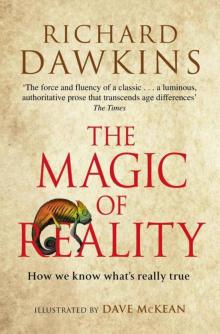 The Magic of Reality
The Magic of Reality The Extended Phenotype
The Extended Phenotype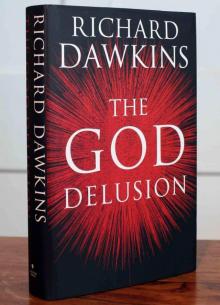 The God Delusion
The God Delusion The Selfish Gene
The Selfish Gene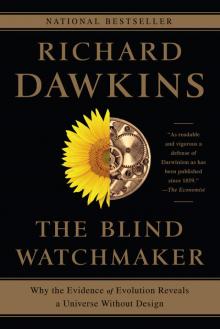 The Blind Watchmaker
The Blind Watchmaker The Greatest Show on Earth
The Greatest Show on Earth Climbing Mount Improbable
Climbing Mount Improbable Outgrowing God
Outgrowing God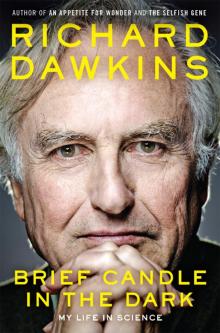 Brief Candle in the Dark
Brief Candle in the Dark The Greatest Show on Earth: The Evidence for Evolution
The Greatest Show on Earth: The Evidence for Evolution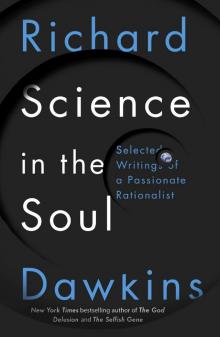 Science in the Soul
Science in the Soul An Appetite for Wonder
An Appetite for Wonder